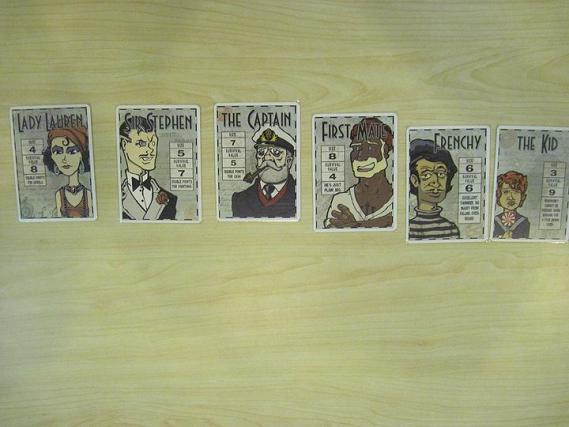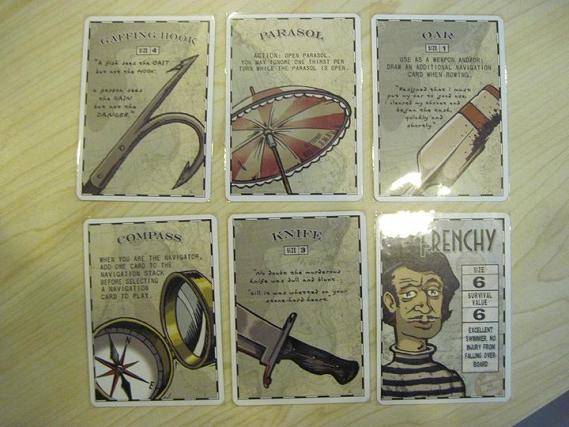
Lifeboat is one of those party games that works only with a sufficiently large group. In the case of our session at CarcaSean, we had six, exactly the number of characters available, making it the perfect setup for this game. This one has an exceptionally strong theme with the gameplay to match. Each player takes the role of one of the characters who are stranded on a lifeboat and must try to survive as best they can until they reach land. As such, each character has a Size value which both determines how much damage he or she can take and how well he or she can do in a Fight, as well as a Survival Value rating which determines how many points the player earns if that character survives until the end of the game.
But to guarantee that things aren’t all fun and games on the boat, each player is also dealt a pair of cards to determine which character he hates and which one he loves. Naturally, you get bonus points if the character you hate is dead at the end of the game as well as points if the character you love is still alive. This is true even if your own character ends up dying. Of course, since this is all random, it’s possible for someone to end up loving himself, in which case, he’s a Narcissist and gets double points for surviving, or to hate himself, in which case he’s a Psychopath and gets points for each dead character.
The game mechanics are simple. The stack of Provisions cards are placed at one end and the character closest to it is the Quartermaster. At the beginning of each turn, as long as there are still cards left in this deck, he or she gets to draw cards equal to the number of conscious characters, pick one to keep and pass the rest down the line. The other players do the same so that the last player doesn’t have a choice over which card he gets. The most common items in the deck are the Water cards, which can be discarded when a character is thirsty to prevent damage. Weapons give a bonus to your Size in fights and there is a variety of special items such the Life Preserver, which prevent damage from being thrown overboard and the Oar, which is both a weapon and helps with rowing. Valuables are worth points if you manage to keep them until the end of the game.

The Kid is a Narcissist.
Then, beginning with the Quartermaster, each player takes an action. He can choose to either pass and do nothing, to row the boat or to make a demand of another character, either to exchange places or for one of the other character’s items. If a character chooses to row, he draws two cards from the Navigation deck, chooses one to return to the bottom of the deck and places the other card aside in a special stack. If he makes a demand instead, the other player can choose to either give in quietly or put up a fight. Fights are straightforward comparisons of the characters’ Size ratings, with ties going to the defender. All other conscious characters can choose to join in to help one of the parties. All characters in the losing side get one damage each and if the attacker wins, he gets what he originally asked for.
Finally, the character at the back of the boat acts as the navigator. If any character has rowed, there will be one or more Navigation cards set aside. The navigator looks through all of them, chooses one to take effect and returns the rest to the bottom of the deck. Otherwise, the navigator draws the top card from the deck to take effect. These cards will show who get thirsty and who gets thrown overboard this turn. In addition, it may also specify that any characters who have rowed or fought gets thirsty. Both of these conditions cause characters to take one damage unless they have the appropriate items to counteract the effects. Most importantly, the card can also show a dove icon. Once four of these birds have appeared, the boat has reached shore and the game is over.
We got a lot of rules wrong in our session so it’s hard to say how representative our experience was. The most important of these that we missed was that once item cards have been played onto the table, they’re discarded whenever the owner gets thrown overboard. This allowed one particular character in our game to accumulate tons of gear and become extremely powerful. We were also confused about what is and isn’t allowed for many of the item cards, such as when it’s legal to play a weapon card onto a table or whether something needs to be discarded after use. Judging by the number of threads on BGG in the Rules section for this game, I’d guess we weren’t the only ones who were a little confused.

But on the whole, I think the game worked well enough for all of us. We had a particularly querulous lifeboat, with at least one fight every turn and no one really wanting to contribute to rowing for fear of the extra thirst penalty. Very amusingly, the toughest character, the First Mate, ended up being the first to die as he kept starting fights and losing them because he misjudged how much support his target had. I had the second weakest character, but due to my strong survival instincts (I never row and never join in fights unless I’m sure my side will win), I was the last to die, except of course for the Frenchie who was the sole survivor of our ill-fated lifeboat.
I’m not sure how this game stands up to repeated play however. Unless someone is a psychopath or something and needs to be extra sneaky, it doesn’t take much time at all to see which camp each player is in and where they’ll stand when a fight breaks out. After that, it’s just a matter of what Navigation and Provisions cards come up. Plus since this is a game in which some characters might die much earlier than others, this is a game with player elimination and comes with all of the associated downsides. Overall, I’d say this is one of better party games I’ve played but that’s coming from someone who’s not a big fan of the genre.
Leave a Reply